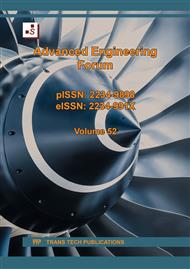[1]
A. M. Dalskyi, et al, Technology of construction materials, Mashinostroeniye, Moscow, 2005.
Google Scholar
[2]
H.-P. Schulze, D. Borkenhagen, S. Burkert, Demands on process and process energy sources for the electro-erosive and electrochemical micro machining, Int. J. Material Forming. 1 (2008) 1383-1386
DOI: 10.1007/s12289-008-0122-0
Google Scholar
[3]
E. Nas, O. Özbek, F. Bayraktar, F. Kara, Experimental and statistical investigation of machinability of AISI D2 steel using electroerosion machining method in different machining parameters", Advances in Materials Sci. & Eng., 2021; 2021: 1241797
DOI: 10.1155/2021/1241797
Google Scholar
[4]
H.-P. Schulze, W. Schätzing. Influences of Different Contaminations on the Electro-Erosive and the Electrochemical Micro-Machining, Procedia CIRP. 6 (2013) 58-63
DOI: 10.1016/j.procir.2013.03.014
Google Scholar
[5]
D. K. Dehkordi, H. A. Kashkuli, K. Mohsenifar, M. Sadeghi-Mianroudi, Assessment of Coagulants Efficiency in Water Treatment of Karoun River, Jundishapur J. Health Sci. 9(3) (2017) e37193.
DOI: 10.5812/jjhs.37193
Google Scholar
[6]
B. F. Shahandashty, N. Fallah, B. Nasernejad, Industrial wastewater treatment: Case study on copper removal from colloidal liquid using coagulation, J. Water Proc. Eng. 53 (2023) 103712
DOI: 10.1016/j.jwpe.2023.103712
Google Scholar
[7]
J. Ma, R. Wang, X. Wang, H. Zhang, B. Zhu, L. Lian, D. Lou, Drinking water treatment by stepwise flocculation using polysilicate aluminum magnesium and cationic polyacrylamide, J. Environ. Chem. Eng. 7(3) (2019) 103049
DOI: 10.1016/j.jece.2019.103049
Google Scholar
[8]
S.S. Wong, T.T. Teng, A.L. Ahmad, A. Zuhairi, G. Najafpour, Treatment of pulp and paper mill wastewater by polyacrylamide (PAM) in polymer induced flocculation, J Hazard. Mater. 135(1–3) (2006) 378-388
DOI: 10.1016/j.jhazmat.2005.11.076
Google Scholar
[9]
R.S. Shatat, S. K. Niazi, F. S. Al Batati, Synthetic Polyelectrolytes based on polyacrylamide: non-ionic, anionic and cationic Polyacrylamides and their applications in water and wastewater treatment: literature review, Chem. Sci. Int. J. 25(4) (2018) 1-8
DOI: 10.9734/CSJI/2018/46483
Google Scholar
[10]
S.B. Buczek, W.G. Cope, R.A. McLaughlin, T.J. Kwak, Acute toxicity of polyacrylamide flocculants to early life stages of freshwater mussels. Environ. Toxicol. Chem. 36 (2017) 2715-2721
DOI: 10.1002/etc.3821
Google Scholar
[11]
C.S. Lee, J. Robinson, M.F. Chong, A review on application of flocculants in wastewater treatment, Proc. Safety & Environ. Protection, 92(6) (2014) 489-508
DOI: 10.1016/j.psep.2014.04.010
Google Scholar
[12]
T. Allen, A review of sedimentation methods of particle size analysis. in: Particle size analysis, N. G. Stanley-Wood and R. W. Lines (Eds), The Royal Society of Chemistry, 1992; pp.454-476
DOI: 10.1039/9781847551627-00454
Google Scholar
[13]
S. Boruk, I. Winkler, S. Gutt, Interparticle interaction in the diluted aqueous suspensions of hydro-mica, J. Food & Environ. Safety. 9(1) (2019) 19-24.
Google Scholar
[14]
S. Boruk, I. Winkler, Influence of some non-ionic surfactants and flocculants on stability of diluted dispersions of kaolin and hydro–mica, J. Food & Environ. Safety. 10(1) (2011) 17-23.
Google Scholar
[15]
S.A. Ravishankar, Pradip, N.K. Khosla, Selective flocculation of iron oxide from its synthetic mixtures with clays: a comparison of polyacrylic acid and starch polymers, Int. J. Mineral Proces. 43(3–4) (1995) 235-247.
DOI: 10.1016/0301-7516(95)00011-2
Google Scholar
[16]
A. Buntin, O. Sirotkin, Studies of sedimentation of modified bentonite suspension with high-molecular weight additives, AIP Conf. Proc. 23 September 2022; 2632 (1): 020027
DOI: 10.1063/5.0098926
Google Scholar
[17]
K. Pourabdollah, Optimization of Coagulation Process of Coke Microparticles for Filtration and Gravity Separation Systems, Nashrieh Shimi va Mohandesi Shimi Iran. 41(4) (2023) 425-443.
Google Scholar


